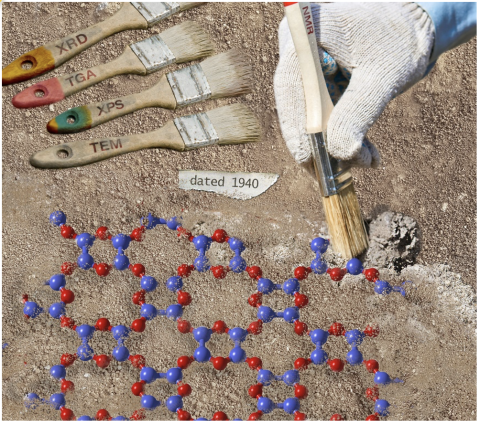In an attempt to identify new 2D materials, a group of researchers from Ames National Laboratory have identified the structure of boron monoxide. In the 1940s, this compound was first discovered and maintained study interest across the years.
 The structure of BO was a longstanding problem, dating back to 1940. Solving it required developing new NMR methods as well as applying x-ray diffraction (XRD), thermogravimetric analysis (TGA), differential scanning calorimetry (DSC), x-ray photo electron spectroscopy (XPS), and transmission electron microscopy (TEM). This research is depicted here as an archeological dig. Image Credit: AMES Laboratory
The structure of BO was a longstanding problem, dating back to 1940. Solving it required developing new NMR methods as well as applying x-ray diffraction (XRD), thermogravimetric analysis (TGA), differential scanning calorimetry (DSC), x-ray photo electron spectroscopy (XPS), and transmission electron microscopy (TEM). This research is depicted here as an archeological dig. Image Credit: AMES Laboratory
With the use of the new NMR methods and updates to analytical tools, the group from Ames Lab ultimately resolved the structure of this deceptively simple material.
We initially weren't really looking into studying this particular material. We were actually trying to make a carbon-free covalent organic framework.
Frédéric Perras, Scientist and Research Team Member, AMES Laboratory
A covalent organic framework is a low-density and porous material that comes with a periodically ordered crystal structure. It is made of organic molecules associated with each other via covalent bonds.
“However, after many synthesis trials, we could not get a highly crystalline covalent organic framework material,” said Wenyu Huang, who is another researcher from Ames Lab and a member of the researchers’ group. Perras’ and Huang’s teams are focusing on these materials for substitutive energy applications.
The research group ended up making a boron-based substance that Perras said was challenging to characterize. With their research, they came across literature that dates back to 1940. It included descriptions of the precise reaction the research group was learning and the synthesis of a material known as boron monoxide. Unfortunately, former researchers could not determine the material’s structure.
Thankfully, since the 1940s, technology for materials research has progressed.
Because of our expertise in nuclear magnetic resonance spectroscopy, and the development of new methods to which people in the 40s, 50s, and 60s didn’t have access, we thought that we might be able to lay this nearly century old mystery to rest.
Frédéric Perras, Scientist and Research Team Member, AMES Laboratory
Perras described that boron monoxide is produced with the use of a precursor molecule that functions like building blocks. Such molecules stick along with each other via dehydration reactions. The basis of understating the structure is to find how the blocks are physically organized.
So we developed some NMR methods that allow us to study the orientation of these building blocks relative to each other. Basically, we found that adjacent precursor molecules were getting organized parallel to each other, which matched one of the previously proposed models. We also applied a lot of other techniques, including powder X-ray diffraction, which showed that these nanosheets organized themselves into what's called a turbostratic arrangement.
Frédéric Perras, Scientist and Research Team Member, AMES Laboratory
He described that these stacked nanosheets resemble a stack of paper thrown onto a desk. Upon landing, they are not flawlessly aligned, but they stay in a stack.
In synthesizing new boron-based 2D materials, as per Perras, there has been a lot of recent interest. Comprehending the structure of this one has the potential to result in the synthesis of other valuable boron-based 2D materials. “What really excites me is just the fact that this is an old problem. It’s such a basic material; when you write down the chemical formula, it’s BO. So, it's interesting from that point of view that we finally solved its structure,” added Perras
This study is further explained in the paper, “The Structure of Boron Monoxide,” written by Frédéric A. Perras, Henry Thomas, Patrick Heintz, Ranjan Behera, Jiaqi Yu, Gayatri Viswanathan, Dapeng Jing, Scott A. Southern, Kirill Kovnir, Levi Stanley, and Wenyu Huang, and published in Journal of the American Chemical Society.
Journal Reference:
Perras, F. A., et al. (2023) The Structure of Boron Monoxide. Journal of the American Chemical Society. doi.org/10.1021/jacs.3c02070.